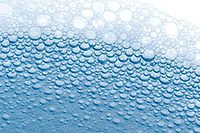Talc Shape and Form Meet Function

Talc products are described as platy talc, containing predominately (>90%) the mineral talc; or tremolitic talc, most often a natural blend of talc, tremolite, serpentine and anthophyllite. Platy talcs can be further classified as microcrystalline or macrocrystalline. Microcrystalline varieties are naturally small in plate size and comprise compact, dense ores. Macrocrystalline varieties contain relatively large, higher aspect ratio plates. The term fibrous talc has in the past been used in reference to tremolitic talc, but this is a distinct misrepresentation.
Talc products are also categorized by geographic origin, which reflects characteristic mineralogy (see Table 1). The so-called western platy talcs, from Montana and Texas, are microcrystalline, with chlorite as a characteristic accessory mineral. Eastern platy talcs, from Vermont and Canada, are macrocrystalline, with carbonates as characteristic accessory minerals, as is the Chinese talc that is readily available in North America.
Because talc is a very soft, platy mineral, the residual minerals in platy talc products can have a subtle effect on properties.
Carbonates, for example, being nodular and relatively hard, might require more grinding than the softer, platy chlorite in order for
a talc product to attain a particular Hegman fineness. Tremolitic talcs exploit the properties contributed by the significant amount
of accessory minerals that occur together with the talc.

The degree of delamination, particle size and aspect ratio, plus the type and amount of residual accessory minerals, all
affect the properties of what otherwise would be considered similar talc grades. For example, Table 2 compares the median
equivalent spherical diameter (ESD) and oil absorption of 4 Hegman talc products from various locations. Included are two
products that are processed to remove the finest particles, so that oil absorption is significantly reduced for use in high-solids
coatings.

Structure
The fundamental structural units common to talc and the related silicate minerals in tremolitic talc are the silica tetrahedron and the magnesia octahedron, as described in the first article of this series.1 All of these minerals contain a magnesium based octahedral layer bound on one or both sides by a layer of silica rings linked through shared oxygen atoms.
Talc
If a continuous sheet of silica rings is attached to both sides of a magnesia layer, the planar talc structure results, as shown in Figure 1.
Because both sides of this structure expose an oxide surface, individual talc plates are held together only by weak van der
Waals forces. Sliding and delamination are therefore relatively easy, giving talc its characteristic soft, slippery feel. Compared to
other silicates, talc is relatively hydrophobic due to the oxide surfaces and the magnesia edges, the latter also accounting for the
mineral's alkaline pH. The oxide surfaces do hydrate to a limited extent on exposure to ambient moisture to form silanol groups,
which improves the compatibility of talc with aqueous media. Figure 2 is a photomicrograph of a 6 Hegman platy talc.

Tremolite/Anthophyllite
The structure of tremolite is analogous to that of wollastonite, with which it shares hardness, morphological features and certain chemical properties. Wollastonite is comprised of single chains of silica tetrahedra connected by calcium in octahedral coordination. Because of this chain structure wollastonite grows as acicular crystals, in some cases of macroscopic dimensions. The tremolite structure is based on a linked double chain of silica. The double chains form the same type of hexagonal rings as in a continuous silica sheet, but they extend in one direction instead of two. These silica "ribbons" are joined to an octahedral magnesia layer on one side and by calcium on the other.
The schematic view of this structure is shown in Figure 3 from an end-on perspective. Tremolite can be viewed as offset
strips of talc strongly linked back-to-back by calcium ions. The structure is dense, rigid, and of high structural integrity, but with
a tendency to fracture lengthwise into blade-like acicular particles. Tremolite is more hydrophilic than talc, due in part to the
solvatable calcium. Anthophyllite is similar in structure to tremolite, with magnesium and a minor amount of iron in place of
calcium.

Serpentine
The serpentine minerals antigorite and lizardite are clay-like constituents of tremolitic talc. They are structurally similar to kaolin clay, which is a platy mineral consisting of a continuous silica sheet joined to a continuous octahedral alumina sheet. Alternatively, they can be considered as a talc-like structure with the silica layer stripped from one side.Antigorite has octahedral magnesia joined to a silica layer, but not without structural stress. The octahedral and tetrahedral layers do not line up very well for the purpose of oxygen sharing. This mismatch is compensated for by a stretching of the apical silica oxygens so that they can form the common oxygen link. This stretching results in structure bending. Antigorite is laminar because its tetrahedral silica layer remains continuous by periodically rotating 180 deg . This, however, prevents the continuity of the octahedral layer. The face of an antigorite platelet is therefore corrugated, as illustrated in Figure 4.
Lizardite is a closer morphological analogue of kaolin. This mineral remains planar because the strain of the
octahedral-tetrahedral mismatch is relieved by the minor substitution of Al3+ for Si4+ in the tetrahedral layer.

Figure 5 is a photomicrograph of a 4 Hegman tremolitic talc demonstrating the multimorphous nature of this natural
mineral blend. The blade-like particles are the tremolite cleavage fragments. Because the platy constituents tend to be fine-grained
and dense, well delaminated particles are confined primarily to the <5mm size fraction.

Properties and Uses
Talc has been used as a paint filler for more than 60 years, starting with linseed oil house paint, which at one time was its single largest use.2 Early outdoor testing showed the value of talc in preventing cracking,3 and exterior house paint remains the major coatings application for talc. Today, the US coatings industry consumes about 180,000 tons/year of talc,4 which is probably used in a wider variety of coatings than any other single mineral pigment. Talc products serve as functional fillers in solvent- and waterborne architectural, industrial, marine and automotive primers and topcoats, traffic paints, powder coatings, joint cements, crack fillers and caulks.Platy Talc
The value of platy talc in coatings is derived primarily from its particle shape and surface properties. Although talc is hydrophobic, it disperses easily in aqueous as well as solventborne coatings. Because of its shape, platy talc can have a beneficial effect on paint rheology. It generally contributes to improved brushability, leveling and sag resistance. It is normally self-suspending in paint vehicles and assists in keeping other pigments suspended. When settling does occur, it is generally soft and is readily redispersed.Platy talcs improve the toughness and general durability of paint films. The talc plates tend to align with the coating's flow so that they are parallel to the substrate in the dry film. This creates a physical barrier to the transmission of moisture, thereby improving water and humidity resistance. This impermeability can aid, however, in the formation of blisters as any moisture or gases leave the substrate. Platy talc reinforces the dry coating film because of its alignment therein and its naturally high aspect ratio. This reinforcement makes the film more resistant to cracking or rupture in response to stretching and flexing, thus better insulating the substrate from the environment. The combination of barrier properties, alkaline pH and reinforcement accounts for talc's contribution to corrosion inhibition.
Its barrier properties also make platy talc well-suited for primers and sanding sealers used on porous substrates to control penetration. In exterior paints, platy talcs tend to chalk more readily than most extender pigments, although less than calcium carbonate.
In liquid coatings, 325 mesh or 4 Hegman talcs are most commonly used. The micronized talcs, 6 Hegman or finer, are
used for TiO2 extension, good low angle sheen and good burnishing resistance. Macrocrystalline varieties are preferred for their
excellent flatting.
Tremolitic Talc
Although not soft or platy, tremolitic talc serves as an alternative to platy talc in many coatings applications. The heterogeneous mineral blend accounts for its functional differences compared to platy talcs. The combination of acicular, nodular and platy particles, ranging in size down to the clay-like serpentines, allows for softer settling, easier redispersion and higher loading levels. These factors likewise allow for better light scattering and thus better color in oil and better dry hide. Flatting efficiency is generally inferior to that of platy talcs. The hardness of the non-talc constituents provides greater scrub resistance and durability.5 In primers, the variety of particle shapes provides more micro-roughness than do flat plates and thus better intercoat adhesion.
Tremolitic talc often provides better film reinforcement, but somewhat greater permeability than platy talc. Barrier
properties are generally not as good, however this reduces the tendency to blister. For corrosion control, greater permeability is
compensated for by greater alkalinity in addition to film durability. In epoxy marine primers, tremolitic talc is preferred for greater
corrosion resistance with less blistering. Tremolitic talcs with 4 Hegman fineness are the most widely used grades in architectural,
industrial and marine coatings.
Conclusion
Talc products, both platy and tremolitic, are perhaps the most broadly functional of the functional fillers used in the coatings industry. Although platy and tremolitic talcs share certain performance features, the versatility they offer to the coatings formulator stems from their differences. Table 3 summarizes the basic properties and the relative advantages of the platy and tremolitic talcs used by the coatings industry. c
For more information on talc, contact RT Vanderbilt Co., phone 203/853.1400; e-mail pciullo@rtvanderbilt.com or
srobinson@rtvanderbilt.com; or visit www.rtvanderbilt.com.
References
1 Ciullo, Peter A.; Robinson, Sara. "Functional Silicate Fillers: Basic Principles," PCI August 2002.2 Madson, W.H. White Hiding and Extender Pigments, Unit 7, Federation of Societies for Paint Technology, 1967.
3 Martens, C.R. Technology of Paints, Varnishes, and Lacquers, Robert.E. Krieger Publishing Co., Melbourne, FL, 1974, p 344.
4 Virta, R.L. Talc and Pyrophyllite, Minerals Yearbook, USGS, Reston, VA, 2001.
5 Ciullo, P.; Anderson J. "Industrial Talc." J. Coatings Technol., Vol. 74, November 2002.
Looking for a reprint of this article?
From high-res PDFs to custom plaques, order your copy today!





